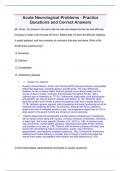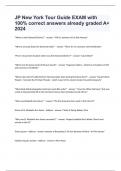Acute Neurological Problems - Practice
Questions and Correct Answers
Mr. Smith, 76, arrives to the clinic with his wife who states that he has had difficulty
focusing on tasks over the past 48 hours. Additionally, he has had difficulty sleeping,
is easily agitated, and has moments of confusion that wax and wane. What is Mr.
Smith likely experiencing?
A. Dementia
B. Delirium
C. Encephalitis
D. Alzheimer's disease
✓ ~~~ Answer: B—Delirium
✓ Dunphy, Winland-Brown, Porter, and Thomas (2015) discuss confusion and possible
differential diagnoses, including delirium and dementia. The main differences
between the two is clearly stated. Delirium typically as an abrupt onset over the
course of days to weeks, confusion that fluctuates throughout the day, with a
hallmark sign of inattention (p. 77-79). Furthermore, sleep-wake cycle disturbances
and agitation can also be found in patients with delirium (p. 79). Dementia slowly
becomes evident over months to years and patients often have a subtle decline (p.
77-79). Aphasia, apraxia, agnosia, and occupational and social functioning can all be
impaired with moderata dementia. Incontinence, difficulty with ADLs, inability to
speak more than 6 intelligible words in a day, and progressive weight loss of 10% of
body weight in the past 6 months are all signs of severe dementia.
✓ Patients diagnosed with encephalitis will often present complaining of a headache
with an abrupt onset, along with nausea, vomiting, confusion, drowsiness, sensitivity
to bright light, and a poor appetite (Dunphy, et al., 2015, p. 138). A physical exam
may reveal fever, nuchal rigidity, paralysis, hyperresponsive deep tendon reflexes,
and possibly a viral rash (p. 138). Patient's with Alzheimer's disease will likely have
issues with remembering recent conversations, events, new information,
appointments, and frequently misplaces objects (p. 108). Furthermore, Alzheimer's
patients have trouble following a complex train of though or performing tasks that
require many steps, and appears more passive and less responsive (p. 108).
In the United States, adult bacterial meningitis is usually caused by:
,A. S. pneumoniae (gram positive cocci)
B. N. meningitides (gram negative diplococci)
C. H. influenza
D. Both A and B.
✓ ~~~ Answer: D—Both A and B.
Rationale: Dunphy, et al., (2015) note that adults bacterial meningitis in the United
States is usually caused by both S. pneumoniae and N. meningitides (p. 134). Both
types of bacteria can colonize the nasopharynx and can gain entry into the
underlying blood vessels as encapsulated bacteria from the infected nasopharyngeal
epithelium (p. 134).
Encephalitis often produces meningeal irritation. How can the APRN distinguish
between encephalitis and meningitis?
A. It is too difficult to distinguish with out diagnostic
testing as both encephalitis and meningitis can
cause altered level of consciousness.
B. Encephalitis will reveal altered level of conscious
from the beginning where as an altered level of
consciousness may appear late in meningitis.
C. Patients with encephalitis will not show signs of
parenchymal damage (memory difficulties,
,confusion, hallucination, dysphasia, seizures, and
focal motor/sensory deficits) and patients with
meningitis will show signs of parenchymal damage.
D. Patients with meningitis will present with a high fever
(>103 F) and patients with encephalitis will not
present with a low grade fever.
✓ ~~~ Answer: B—Encephalitis will reveal altered level of consciousness from the
beginning where as an altered level of consciousness may appear late in the course
of meningitis.
Rationale: Dunphy, et al., (2015) specifically address the importance of being able to
distinguish the difference between encephalitis and meningitis by stating, the
differentiating factor to consider encephalitis over meningitis is usually alteration in
level of consciousness. Meningitis has an abrupt onset by signs of parenchymal
damage appear late in the course, where alteration in level of consciousness is
evident from the beginning with encephalitis (p. 139). While it is difficult to distinguish
between the two, a thorough history and physical will assist the APRN in a correct
differential diagnosis. Finally, patients with meningitis often present with a high fever
(>103 F) and patients with encephalitis will typically present with a fever as well (p.
135, 138).
Which of the following headaches is considered a medical emergency:
A. Tension headache
B. Migraine headache
C. Cluster headache
, D. Traction or inflammatory headache
✓ ~~~ Answer: D—Traction or inflammatory headache.
Rationale: Dunphy, et al., (2015) discusses the four general classes of headaches,
and while all of them have the potential to impact level of functions and work
performance, a traction or inflammatory headache is an acute new-onset headache
that has an increasing intensity and is considered a medical emergency because it
may be symptomatic of a more serious condition (i.e., subarachnoid hemorrhage or
infection) (p. 121-122). A tension headache presents as a mild to moderate bilateral,
nonpulsating, tightening pain that is not aggravated by routine physical activity (p.
121). A migraine headache may last for 4 to 72 hours and may or may not be
precipitated by an aura and is usually moderate to severe intensity with pulsating
quality, aggravated by routine physical activity, and accompanied by nausea,
vomiting, and photophobia (p. 121). A cluster headache usually occurs at night and
may last 15 to 180 minutes with severe unilateral orbital, supraorbital, and/or pain
that is accompanied on the same side of the face with sweating, lacrimation, nasal
congestion, ptosis, rhinorrhea, eyelid edema, and/or conjunctival injection (p. 121).
Mr. Johnson, 65, presents to the clinic with complaints of weakness of his left arm
and hand and blurred vision in left eye. He states that he has had several episodes
and the symptoms usually lasts for a few hours and resolve on its own. He states
that he recently quit smoking and has hypertension and hyperlipidemia. What is the
likely diagnosis for Mr. Johnson?
A. CVA
B. TIA





